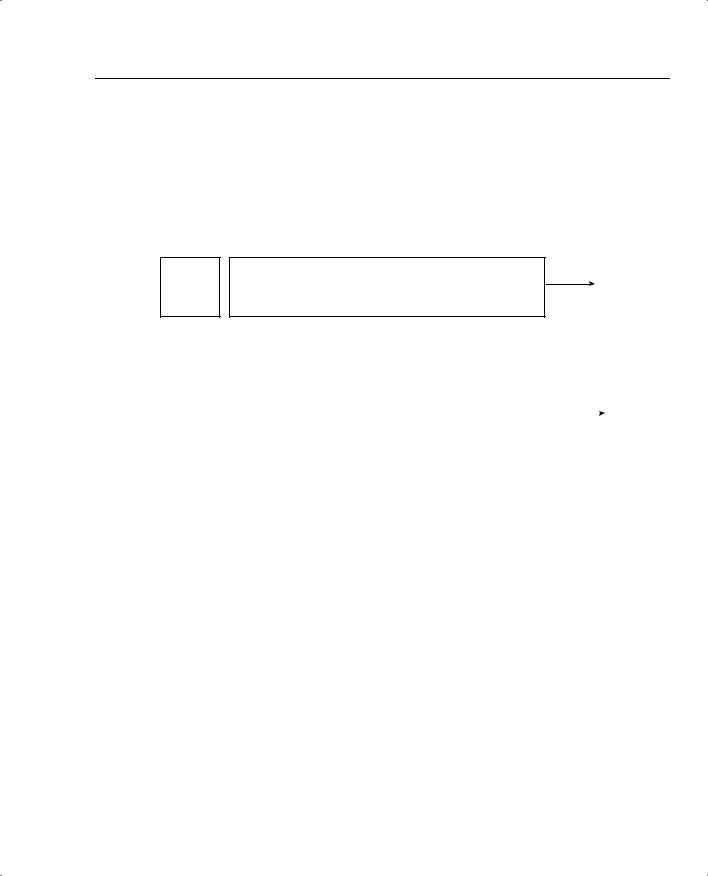
- •QoS Overview
- •“Do I Know This Already?” Quiz
- •QoS: Tuning Bandwidth, Delay, Jitter, and Loss Questions
- •Foundation Topics
- •QoS: Tuning Bandwidth, Delay, Jitter, and Loss
- •Bandwidth
- •The clock rate Command Versus the bandwidth Command
- •QoS Tools That Affect Bandwidth
- •Delay
- •Serialization Delay
- •Propagation Delay
- •Queuing Delay
- •Forwarding Delay
- •Shaping Delay
- •Network Delay
- •Delay Summary
- •QoS Tools That Affect Delay
- •Jitter
- •QoS Tools That Affect Jitter
- •Loss
- •QoS Tools That Affect Loss
- •Summary: QoS Characteristics: Bandwidth, Delay, Jitter, and Loss
- •Voice Basics
- •Voice Bandwidth Considerations
- •Voice Delay Considerations
- •Voice Jitter Considerations
- •Voice Loss Considerations
- •Video Basics
- •Video Bandwidth Considerations
- •Video Delay Considerations
- •Video Jitter Considerations
- •Video Loss Considerations
- •Comparing Voice and Video: Summary
- •IP Data Basics
- •Data Bandwidth Considerations
- •Data Delay Considerations
- •Data Jitter Considerations
- •Data Loss Considerations
- •Comparing Voice, Video, and Data: Summary
- •Foundation Summary
- •QoS Tools and Architectures
- •“Do I Know This Already?” Quiz
- •QoS Tools Questions
- •Differentiated Services Questions
- •Integrated Services Questions
- •Foundation Topics
- •Introduction to IOS QoS Tools
- •Queuing
- •Queuing Tools
- •Shaping and Policing
- •Shaping and Policing Tools
- •Congestion Avoidance
- •Congestion-Avoidance Tools
- •Call Admission Control and RSVP
- •CAC Tools
- •Management Tools
- •Summary
- •The Good-Old Common Sense QoS Model
- •GOCS Flow-Based QoS
- •GOCS Class-Based QoS
- •The Differentiated Services QoS Model
- •DiffServ Per-Hop Behaviors
- •The Class Selector PHB and DSCP Values
- •The Assured Forwarding PHB and DSCP Values
- •The Expedited Forwarding PHB and DSCP Values
- •The Integrated Services QoS Model
- •Foundation Summary
- •“Do I Know This Already?” Quiz Questions
- •CAR, PBR, and CB Marking Questions
- •Foundation Topics
- •Marking
- •IP Header QoS Fields: Precedence and DSCP
- •LAN Class of Service (CoS)
- •Other Marking Fields
- •Summary of Marking Fields
- •Class-Based Marking (CB Marking)
- •Network-Based Application Recognition (NBAR)
- •CB Marking show Commands
- •CB Marking Summary
- •Committed Access Rate (CAR)
- •CAR Marking Summary
- •Policy-Based Routing (PBR)
- •PBR Marking Summary
- •VoIP Dial Peer
- •VoIP Dial-Peer Summary
- •Foundation Summary
- •Congestion Management
- •“Do I Know This Already?” Quiz
- •Queuing Concepts Questions
- •WFQ and IP RTP Priority Questions
- •CBWFQ and LLQ Questions
- •Comparing Queuing Options Questions
- •Foundation Topics
- •Queuing Concepts
- •Output Queues, TX Rings, and TX Queues
- •Queuing on Interfaces Versus Subinterfaces and Virtual Circuits (VCs)
- •Summary of Queuing Concepts
- •Queuing Tools
- •FIFO Queuing
- •Priority Queuing
- •Custom Queuing
- •Weighted Fair Queuing (WFQ)
- •WFQ Scheduler: The Net Effect
- •WFQ Scheduling: The Process
- •WFQ Drop Policy, Number of Queues, and Queue Lengths
- •WFQ Summary
- •Class-Based WFQ (CBWFQ)
- •CBWFQ Summary
- •Low Latency Queuing (LLQ)
- •LLQ with More Than One Priority Queue
- •IP RTP Priority
- •Summary of Queuing Tool Features
- •Foundation Summary
- •Conceptual Questions
- •Priority Queuing and Custom Queuing
- •CBWFQ, LLQ, IP RTP Priority
- •Comparing Queuing Tool Options
- •“Do I Know This Already?” Quiz
- •Shaping and Policing Concepts Questions
- •Policing with CAR and CB Policer Questions
- •Shaping with FRTS, GTS, DTS, and CB Shaping
- •Foundation Topics
- •When and Where to Use Shaping and Policing
- •How Shaping Works
- •Where to Shape: Interfaces, Subinterfaces, and VCs
- •How Policing Works
- •CAR Internals
- •CB Policing Internals
- •Policing, but Not Discarding
- •Foundation Summary
- •Shaping and Policing Concepts
- •“Do I Know This Already?” Quiz
- •Congestion-Avoidance Concepts and RED Questions
- •WRED Questions
- •FRED Questions
- •Foundation Topics
- •TCP and UDP Reactions to Packet Loss
- •Tail Drop, Global Synchronization, and TCP Starvation
- •Random Early Detection (RED)
- •Weighted RED (WRED)
- •How WRED Weights Packets
- •WRED and Queuing
- •WRED Summary
- •Flow-Based WRED (FRED)
- •Foundation Summary
- •Congestion-Avoidance Concepts and Random Early Detection (RED)
- •Weighted RED (WRED)
- •Flow-Based WRED (FRED)
- •“Do I Know This Already?” Quiz
- •Compression Questions
- •Link Fragmentation and Interleave Questions
- •Foundation Topics
- •Payload and Header Compression
- •Payload Compression
- •Header Compression
- •Link Fragmentation and Interleaving
- •Multilink PPP LFI
- •Maximum Serialization Delay and Optimum Fragment Sizes
- •Frame Relay LFI Using FRF.12
- •Choosing Fragment Sizes for Frame Relay
- •Fragmentation with More Than One VC on a Single Access Link
- •FRF.11-C and FRF.12 Comparison
- •Foundation Summary
- •Compression Tools
- •LFI Tools
- •“Do I Know This Already?” Quiz
- •Foundation Topics
- •Call Admission Control Overview
- •Call Rerouting Alternatives
- •Bandwidth Engineering
- •CAC Mechanisms
- •CAC Mechanism Evaluation Criteria
- •Local Voice CAC
- •Physical DS0 Limitation
- •Max-Connections
- •Voice over Frame Relay—Voice Bandwidth
- •Trunk Conditioning
- •Local Voice Busyout
- •Measurement-Based Voice CAC
- •Service Assurance Agents
- •SAA Probes Versus Pings
- •SAA Service
- •Calculated Planning Impairment Factor
- •Advanced Voice Busyout
- •PSTN Fallback
- •SAA Probes Used for PSTN Fallback
- •IP Destination Caching
- •SAA Probe Format
- •PSTN Fallback Scalability
- •PSTN Fallback Summary
- •Resource-Based CAC
- •Resource Availability Indication
- •Gateway Calculation of Resources
- •RAI in Service Provider Networks
- •RAI in Enterprise Networks
- •RAI Operation
- •RAI Platform Support
- •Cisco CallManager Resource-Based CAC
- •Location-Based CAC Operation
- •Locations and Regions
- •Calculation of Resources
- •Automatic Alternate Routing
- •Location-Based CAC Summary
- •Gatekeeper Zone Bandwidth
- •Gatekeeper Zone Bandwidth Operation
- •Single-Zone Topology
- •Multizone Topology
- •Zone-per-Gateway Design
- •Gatekeeper in CallManager Networks
- •Zone Bandwidth Calculation
- •Gatekeeper Zone Bandwidth Summary
- •Integrated Services / Resource Reservation Protocol
- •RSVP Levels of Service
- •RSVP Operation
- •RSVP/H.323 Synchronization
- •Bandwidth per Codec
- •Subnet Bandwidth Management
- •Monitoring and Troubleshooting RSVP
- •RSVP CAC Summary
- •Foundation Summary
- •Call Admission Control Concepts
- •Local-Based CAC
- •Measurement-Based CAC
- •Resources-Based CAC
- •“Do I Know This Already?” Quiz
- •QoS Management Tools Questions
- •QoS Design Questions
- •Foundation Topics
- •QoS Management Tools
- •QoS Device Manager
- •QoS Policy Manager
- •Service Assurance Agent
- •Internetwork Performance Monitor
- •Service Management Solution
- •QoS Management Tool Summary
- •QoS Design for the Cisco QoS Exams
- •Four-Step QoS Design Process
- •Step 1: Determine Customer Priorities/QoS Policy
- •Step 2: Characterize the Network
- •Step 3: Implement the Policy
- •Step 4: Monitor the Network
- •QoS Design Guidelines for Voice and Video
- •Voice and Video: Bandwidth, Delay, Jitter, and Loss Requirements
- •Voice and Video QoS Design Recommendations
- •Foundation Summary
- •QoS Management
- •QoS Design
- •“Do I Know This Already?” Quiz
- •Foundation Topics
- •The Need for QoS on the LAN
- •Layer 2 Queues
- •Drop Thresholds
- •Trust Boundries
- •Cisco Catalyst Switch QoS Features
- •Catalyst 6500 QoS Features
- •Supervisor and Switching Engine
- •Policy Feature Card
- •Ethernet Interfaces
- •QoS Flow on the Catalyst 6500
- •Ingress Queue Scheduling
- •Layer 2 Switching Engine QoS Frame Flow
- •Layer 3 Switching Engine QoS Packet Flow
- •Egress Queue Scheduling
- •Catalyst 6500 QoS Summary
- •Cisco Catalyst 4500/4000 QoS Features
- •Supervisor Engine I and II
- •Supervisor Engine III and IV
- •Cisco Catalyst 3550 QoS Features
- •Cisco Catalyst 3524 QoS Features
- •CoS-to-Egress Queue Mapping for the Catalyst OS Switch
- •Layer-2-to-Layer 3 Mapping
- •Connecting a Catalyst OS Switch to WAN Segments
- •Displaying QoS Settings for the Catalyst OS Switch
- •Enabling QoS for the Catalyst IOS Switch
- •Enabling Priority Queuing for the Catalyst IOS Switch
- •CoS-to-Egress Queue Mapping for the Catalyst IOS Switch
- •Layer 2-to-Layer 3 Mapping
- •Connecting a Catalyst IOS Switch to Distribution Switches or WAN Segments
- •Displaying QoS Settings for the Catalyst IOS Switch
- •Foundation Summary
- •LAN QoS Concepts
- •Catalyst 6500 Series of Switches
- •Catalyst 4500/4000 Series of Switches
- •Catalyst 3550/3524 Series of Switches
- •QoS: Tuning Bandwidth, Delay, Jitter, and Loss
- •QoS Tools
- •Differentiated Services
- •Integrated Services
- •CAR, PBR, and CB Marking
- •Queuing Concepts
- •WFQ and IP RTP Priority
- •CBWFQ and LLQ
- •Comparing Queuing Options
- •Conceptual Questions
- •Priority Queuing and Custom Queuing
- •CBWFQ, LLQ, IP RTP Priority
- •Comparing Queuing Tool Options
- •Shaping and Policing Concepts
- •Policing with CAR and CB Policer
- •Shaping with FRTS, GTS, DTS, and CB Shaping
- •Shaping and Policing Concepts
- •Congestion-Avoidance Concepts and RED
- •WRED
- •FRED
- •Congestion-Avoidance Concepts and Random Early Detection (RED)
- •Weighted RED (WRED)
- •Flow-Based WRED (FRED)
- •Compression
- •Link Fragmentation and Interleave
- •Compression Tools
- •LFI Tools
- •Call Admission Control Concepts
- •Local-Based CAC
- •Measurement-Based CAC
- •Resources-Based CAC
- •QoS Management Tools
- •QoS Design
- •QoS Management
- •QoS Design
- •LAN QoS Concepts
- •Catalyst 6500 Series of Switches
- •Catalyst 4500/4000 Series of Switches
- •Catalyst 3550/3524 Series of Switches
- •Foundation Topics
- •QPPB Route Marking: Step 1
- •QPPB Per-Packet Marking: Step 2
- •QPPB: The Hidden Details
- •QPPB Summary
- •Flow-Based dWFQ
- •ToS-Based dWFQ
- •Distributed QoS Group–Based WFQ
- •Summary: dWFQ Options

494 Chapter 7: Link-Efficiency Tools
To enable RTP header compression, the frame-relay ip rtp header-compression command was added to both serial subinterfaces on R1 and R3. (If a multipoint subinterface had been used instead, the same parameters could have been configured on a frame-relay map command.)
The show frame-relay ip rtp header-compression command lists statistics about how well cRTP is working. You might recall that cRTP reduces the 40 bytes of IP, UDP, and RTP header to between 2 and 4 bytes, saving between 36 and 38 bytes per packet. In the output in the example, with 16,992 packets compressed, a savings of 645,645 bytes is realized, which is an average per-packet savings of 37.99 bytes.
The show frame-relay ip rtp header-compression command output also lists an efficiency improvement factor, which is the compression ratio. It is calculated as the number of bytes that would have been sent without compression, divided by the actual number of bytes sent. From the shaded lines at the end of the preceding example, 645,645 + 373,875 bytes would have been sent (the number of bytes saved, plus actual number sent), for a total of 1,019,520 bytes that would have been sent. Dividing that total by the actual number sent (373,875) gives you the improvement factor of 2.72. For perspective, if you divide the packet size of a G.729 VoIP packet (60 bytes), by the compressed size of 22 bytes (which implies you saved 38 of the
40 bytes in the header), the ratio also calculates to 2.72. Therefore, the empirical ratio from the show command matches the theoretical ratio between bytes that would have been sent, and bytes that are actually sent, with cRTP.
Link Fragmentation and Interleaving
Both types of QoS tools covered in this chapter address bandwidth constraints to some degree. Compression tools directly attack bandwidth constraints by lowering the bandwidth required to forward packets. Link fragmentation and interleaving (LFI) tools directly lower delay by defeating a side effect of a small transmit clock speed, namely serialization delay.
A quick review of serialization delay should help you make more sense out of LFI tools. Serialization is the time required to send a frame over a physical link. If a link has a physical clock rate of x bps, it takes 1/x seconds to send a single bit. If a frame has y bits in it, it takes y/x seconds to serialize the frame. The faster the link, the lower the serialization delay. On a 56kbps link, for example, it takes 1/56,000 of a second to send 1 bit. A 1500-byte frame (12,000 bits) takes 12,000/56,000 seconds to serialize, or roughly 214 ms.
When a router starts to send a frame out of an interface, it sends the complete frame. If a small, delay-sensitive frame needs to exit an interface, and the router has just begun to send a large frame, the small frame must wait until the whole large frame has been sent before the router will send the small, delay–sensitive frame. As seen in the preceding example, a 1500-byte frame takes 214 ms to serialize at 56 kbps, which is far too long for the small frame to wait if it is part of a VoIP stream.

Link Fragmentation and Interleaving 495
LFI tools attack the serialization delay problem by ensuring that large packets do not delay smaller packets. It accomplishes this by dividing larger packets (fragmentation) and interleaving later-arriving smaller packets with the fragments from the larger packet. The smaller, delaysensitive interleaved packets, typically VoIP, are defined in your QoS policy. Figure 7-5 outlines the basic process.
Figure 7-5 Basic Concept Behind LFI Tools
Interface Output Queue, no LFI
Delay
Sensitive
60 Byte 1500 Byte Packet
Packet
|
|
|
Interface Output Queue, with LFI, 300 Byte Fragments |
|
|||||||
300 Byte |
|
300 Byte |
|
300 Byte |
|
300 Byte |
|
Delay |
|
300 Byte |
|
Fragment |
|
Fragment |
|
Fragment |
|
Fragment |
|
Sensitive |
|
Fragment |
|
#5 of |
|
#4 of |
|
#3 of |
|
#2 of |
|
60 Byte |
|
#1 of |
|
Original |
|
Original |
|
Original |
|
Original |
|
Packet |
|
Original |
|
|
|
|
|
|
|
|
|
|
|
|
|
As shown in the upper queue in the figure, without LFI, the small 60-byte packet must wait for the full 1500-byte packet to be forwarded. In the lower queue, with LFI enabled, IOS can choose to let the smaller packet exit the interface ahead of some of the fragments of the larger packet.
Before examining LFI in more detail, you need to take a closer look at the terms “packet” and “frame.” In most cases in this book, these terms have been used interchangeably. However, it is important to realize what really gets placed into the queues, and what really gets fragmented, when discussing LFI tools.
First, we need a shared definition of what each of the two terms mean. Packet refers to the entity that flows through the network, including the Layer 3 header, all headers from layers above Layer 3, and the end-user data. Packets do not include the data-link (Layer 2) headers and trailers. Frames include the packet, as well as the data-link (Layer 2) header and trailer.
Queuing tools actually place frames into the queues. For instance, Weighted Fair Queuing (WFQ) on a PPP serial interface places PPP frames into the queues. Concerning queuing tools, the distinction does not really have much bearing on the choices you make. In addition, because most people tend to use the term “packet” more often, this book just uses packet when it does not matter whether you care about the packet or the frame.

496 Chapter 7: Link-Efficiency Tools
LFI tools require you to think about what happens to the packet, and what happens to the frame. Consider Figure 7-6, which shows some of the details of an unfragmented frame, and a fragmented frame, using Frame Relay.
Figure 7-6 LFI Application to Packets and Frames, 1500-Byte Packet
Unfragmented |
|
1509 Byte Frame |
|
|
|
|
|
FR Header |
|
1500 byte packet |
FR Trailer |
(6 bytes) |
|
|
(3 bytes) |
|
|
|
|
FR Header |
500 byte |
FR Trailer |
(8 bytes) |
packet |
(3 bytes) |
|
|
|
FR Header |
500 byte |
FR Trailer |
(8 bytes) |
packet |
(3 bytes) |
|
|
|
FR Header |
500 byte |
FR Trailer |
(8 bytes) |
packet |
(3 bytes) |
|
|
|
Fragmented |
511 Byte Frame |
|
|
|
Fragmented |
511 Byte Frame |
Fragment Size 511
In the upper part of the figure, a 1500-byte packet has an extra 9 bytes of Frame Relay header and trailer added to it, to form a 1509-byte frame. In the lower part of the figure, the 1500-byte packet has been fragmented into three 500-byte fragments, and then placed into Frame Relay frames. It turns out that with FRF.12 LFI, an additional 2 bytes of header are needed to manage the fragments, so each of the three frames totals 511 bytes in length.
Technically, the fragment size used in the figure is 511 bytes, not 500. Most people would tend to think something like “the router fragmented the 1500-byte packet into three 500-byte fragments.” In reality, the router performs logic like in the following list:
•The router fragments the packet into smaller pieces.
•The router adds the appropriate data-link headers and trailers, including any headers specifically needed for fragmentation support.
•The length of the resulting frames (including data-link headers/trailers) does not exceed the fragmentation size configured.
•The router adds these frames to the appropriate queue.
So, the router fragments packets into smaller pieces, but the size of the pieces is determined by the fragment size, which is based on the frame size. Therefore, does LFI really fragment packets, or frames? Frankly, either term works. When you are choosing the size of the fragments, however, always remember that the fragment size determines the size of the frames, not the packets. Therefore, you should consider the length of the data-link headers and trailers when choosing the size of the fragments.
